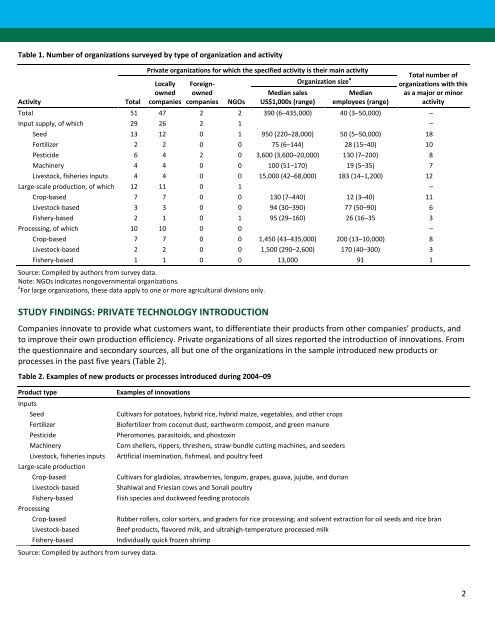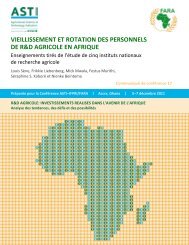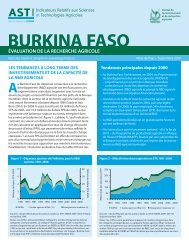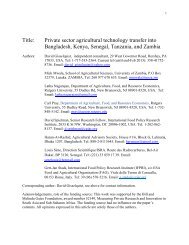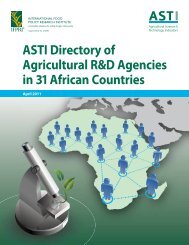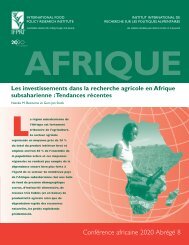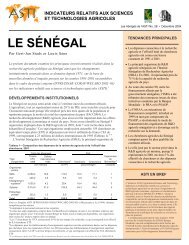Bangladesh country report - ASTI - cgiar
Bangladesh country report - ASTI - cgiar
Bangladesh country report - ASTI - cgiar
Create successful ePaper yourself
Turn your PDF publications into a flip-book with our unique Google optimized e-Paper software.
Table 1. Number of organizations surveyed by type of organization and activity<br />
Activity<br />
Total<br />
Private organizations for which the specified activity is their main activity<br />
Locally Foreignowned<br />
Median sales<br />
Median<br />
Organization size a<br />
owned<br />
companies companies NGOs US$1,000s (range) employees (range)<br />
Total number of<br />
organizations with this<br />
as a major or minor<br />
activity<br />
Total 51 47 2 2 390 (6–435,000) 40 (3–50,000) –<br />
Input supply, of which 29 26 2 1 –<br />
Seed 13 12 0 1 950 (220–28,000) 50 (5–50,000) 18<br />
Fertilizer 2 2 0 0 75 (6–144) 28 (15–40) 10<br />
Pesticide 6 4 2 0 3,600 (3,600–20,000) 130 (7–200) 8<br />
Machinery 4 4 0 0 100 (51–170) 19 (5–35) 7<br />
Livestock, fisheries inputs 4 4 0 0 15,000 (42–68,000) 183 (14–1,200) 12<br />
Large-scale production, of which 12 11 0 1 –<br />
Crop-based 7 7 0 0 130 (7–440) 12 (3–40) 11<br />
Livestock-based 3 3 0 0 94 (30–390) 77 (50–90) 6<br />
Fishery-based 2 1 0 1 95 (29–160) 26 (16–35 3<br />
Processing, of which 10 10 0 0 –<br />
Crop-based 7 7 0 0 1,450 (43–435,000) 200 (13–10,000) 8<br />
Livestock-based 2 2 0 0 1,500 (290–2,600) 170 (40–300) 3<br />
Fishery-based 1 1 0 0 13,000 91 1<br />
Source: Compiled by authors from survey data.<br />
Note: NGOs indicates nongovernmental organizations.<br />
a For large organizations, these data apply to one or more agricultural divisions only.<br />
STUDY FINDINGS: PRIVATE TECHNOLOGY INTRODUCTION<br />
Companies innovate to provide what customers want, to differentiate their products from other companies’ products, and<br />
to improve their own production efficiency. Private organizations of all sizes <strong>report</strong>ed the introduction of innovations. From<br />
the questionnaire and secondary sources, all but one of the organizations in the sample introduced new products or<br />
processes in the past five years (Table 2).<br />
Table 2. Examples of new products or processes introduced during 2004–09<br />
Product type<br />
Inputs<br />
Seed<br />
Fertilizer<br />
Pesticide<br />
Machinery<br />
Livestock, fisheries inputs<br />
Large-scale production<br />
Crop-based<br />
Livestock-based<br />
Fishery-based<br />
Processing<br />
Crop-based<br />
Livestock-based<br />
Fishery-based<br />
Examples of innovations<br />
Cultivars for potatoes, hybrid rice, hybrid maize, vegetables, and other crops<br />
Biofertilizer from coconut dust, earthworm compost, and green manure<br />
Pheromones, parasitoids, and phostoxin<br />
Corn shellers, rippers, threshers, straw-bundle cutting machines, and seeders<br />
Artificial insemination, fishmeal, and poultry feed<br />
Cultivars for gladiolas, strawberries, longum, grapes, guava, jujube, and durian<br />
Shahiwal and Friesian cows and Sonali poultry<br />
Fish species and duckweed feeding protocols<br />
Rubber rollers, color sorters, and graders for rice processing; and solvent extraction for oil seeds and rice bran<br />
Beef products, flavored milk, and ultrahigh-temperature processed milk<br />
Individually quick frozen shrimp<br />
Source: Compiled by authors from survey data.<br />
2


